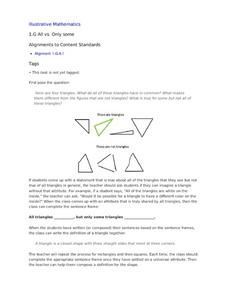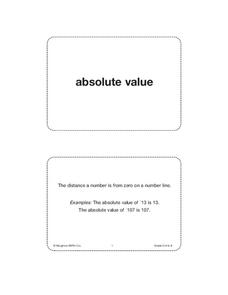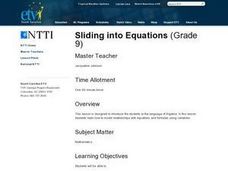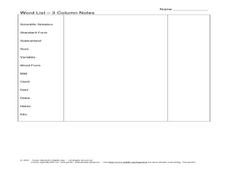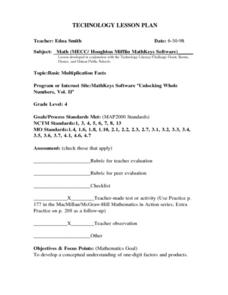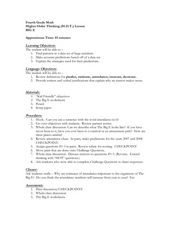Curated OER
Problem Solving Model
Use a vocabulary chart to introduce math functions. The class defines a list of mathematical vocabulary terms on a worksheet, as well as completes equations and expressions. They examine word problems and practice transcribing them into...
Illustrative Mathematics
All vs. Only Some
All shapes have certain defining attributes that set them apart from others. In order to understand this, young mathematicians look at examples and non-examples of triangles, rectangles, and squares, working as a whole class to create...
Balanced Assessment
Disc-Ness
Transform your scholars into mathematicians as they develop their own geometric definition. The task asks individuals to compare cylindrical objects and create a definition for the disc-ness of each object. They may use any method and...
Houghton Mifflin Harcourt
Unit 8 Math Vocabulary Cards (Grade 5)
Reinforce math vocabulary with a set of flash cards. With a total of forty-eight cards, each are printed in bold font, and include definition cards that offer a labeled example. Terms include absolute value, ordered...
Houghton Mifflin Harcourt
Unit 4 Math Vocabulary Cards (Grade 3)
Bring a set of 19 math vocabulary cards to your third grade math class. Each sheet contains two cards. The top half has the vocabulary word printed in bold text, while the bottom half has the definition of the word. Card topics...
Houghton Mifflin Harcourt
Unit 2 Math Vocabulary Cards (Grade 4)
The 28-page resource contains cards with terms relating to multiplication from inverse operations to front-end estimation to array. Each sheet contains two cards; one with the word and one with the definition.
Water
Global Water Supply Elementary School Curriculum
Water is the focus of an interdisciplinary unit that brings awareness to its daily use around the world and the importance of conservation. Worksheets challenge scholars to match words and definitions, trace, complete a maze, and solve a...
EngageNY
Equivalent Ratios
Equivalent ratios show up on tape. Young mathematicians use tape diagrams to create equivalent ratios in the initial lesson on the topic. They learn the definition of equivalent ratios and use it to build others in the third segment of a...
Balanced Assessment
Sharp-Ness
Transform pupils into mathematicians as they create their own definitions and formulas. Scholars examine an assortment of triangles and create a definition and formula for determining the sharpness of the vertex angle. The groups of...
Balanced Assessment
Bumpy-Ness
Develop a new measure of the properties of an object. Scholars develop a definition and formula to measure the bumpy-ness of an object. They utilize their formulas to find the property for several spherical objects.
Curated OER
An Introduction To Volume
Upper graders explore the topic of volume. In this math lesson plan, pupils count volume in cubic units, multiply to find volume, estimate volume, write a multiplication sentence to find the volume, and make a cost analysis of different...
Curated OER
Calculate the Slope of a Line Using Two Points
Find that slope! This video does an excellent job of demonstrating how to use the slope formula to find the slope of a line using two points. The instructor first reviews the definition of slope of a line, then works three problems using...
Worksheet Web
Using Pictographs
If one ice cream cone represents three ice cream scoops, and Bob has four ice cream cones, then how many scoops does Bob have? Learners solve these kind of questions with their new understanding of pictographs.
Curated OER
Sliding into Equations
Ninth graders translate sentences into equations. They translate equations into sentences. They solve real life problems using verbal models to write equations. They create a problem solution graphic organizer in their journals.
Curated OER
Column notes - math vocabulary
In this math vocabulary worksheet, students fill in a column notes sheet with the definition and example of math vocabulary words. Students complete this for 26 words.
Curated OER
Math Vocabulary
In this math vocabulary worksheet, 6th graders match twenty-three math vocabulary words from column A to the definitions in column B.
Curated OER
Basic Multiplication Facts - MathKeys Software
Students explore multiplication concepts. In this multiplication lesson, students define "array" and draw several arrays to represent multiplication number sentences. Students construct arrays on the computer using MathKeys...
Curated OER
Worksheet 1
In this math worksheet, students give examples of functions that will satisfy given conditions. Students tell the tabulations for a given function. Students use the definition of a derivative to compute the inverse of a function. they...
Curated OER
Dr. Nestler's Math 2 Pre-calculus
Students are given a description of a scenario of Professor Fink searching for a group of children. When he finds them, he states that he can express their location as a function of his hand. Students analyze the scenario and determine...
Curated OER
Higher Order Thinking (H.O.T.) Lesson - BIG E
Fourth graders work with patterns while using large numbers. In this patterning lesson, 4th graders go over the definitions of the words: predict, estimate, attendance, increase, and decrease. They complete worksheets in which they track...
Curated OER
Right Angles__Fill in the Blanks
In this algebra worksheet, students analyze the use of right angles to make a puzzle grid. They then complete a puzzle where they have to finish the sentence using a created grid.
EngageNY
Writing Equations Using Symbols
Build upon prior equation writing experience to create more complicated equations. Lesson one in a 33-part unit builds upon the class members' sixth and seventh grade experience of writing linear equations. Several examples...
Curated OER
Commutative Property
First graders investigate the Commutative Property of Addition. It is introduced using models such as students, counters, balances and dominoes. They discover the order of the numbers in an addition sentence does not change the result...
Curated OER
Commutative Property
First graders use various models to learn the Commutative Property of Addition. In this Commutative Property lesson, 1st graders use other students, counters, balances, and dominoes to apply the addition property. Students solve addition...

